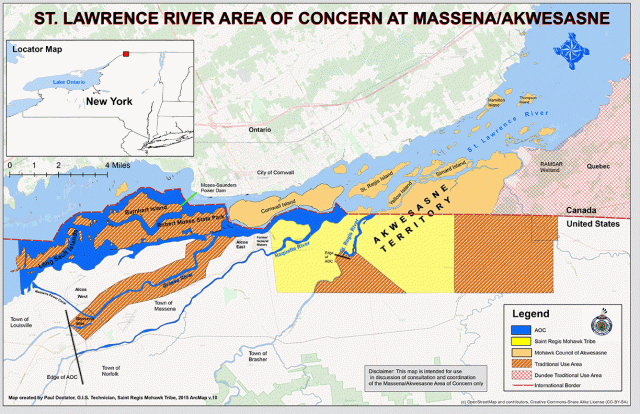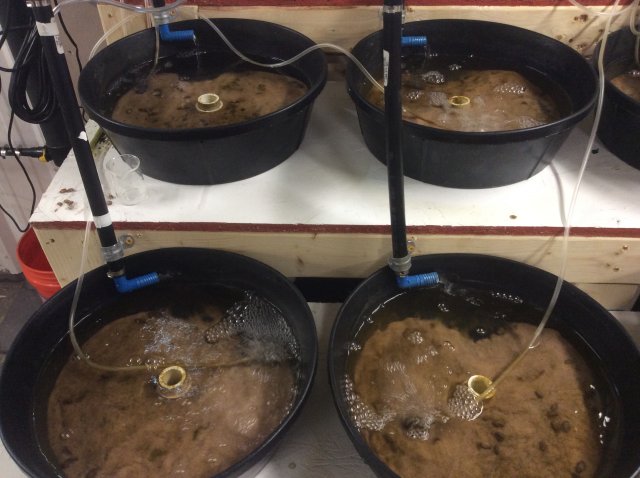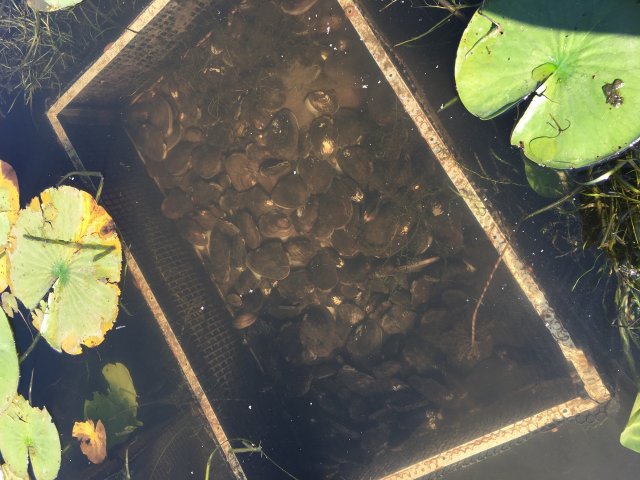St. Lawrence River Area of Concern at Massena/Akwesasne
- Daniel Gurdak (Gurdak.Daniel@epa.gov) 212-637-3634
Overview
The St. Lawrence River Area of Concern (AOC) is a bi-national AOC shared between the United States, New York state and the Saint Regis Mohawk Tribe (SRMT).
There have been many activities leading to improvements in water quality in the AOC since 1987, including remediation of hazardous waste sites and contaminated sediments, and source control activities. Hazardous wastes have contaminated soils, river sediments, groundwater, and plant and animal life with toxic chemicals, including polychlorinated biphenyls (PCBs) and metals.
Sources of pollution in this AOC include historical industrial discharges, municipal treatment facilities, atmospheric deposition, non-point source discharges, and power dam and seaway construction. The efforts to clean and restore the AOC are ongoing and will improve the overall environment and positively impact the native fish and wildlife communities.
Beneficial Use Impairments
- Restrictions on Fish and Wildlife Consumption
- Loss of Fish and Wildlife Habitat
- Degradation of Fish and Wildlife Populations
- Fish Tumors or Other Deformities
- Bird or Animal Deformities or Reproduction Problems
- Degradation of Benthos
- Degradation of Phytoplankton and Zooplankton Populations (pdf) – Removed August 2015
Remediation and Restoration Work
- Documents on Restoring St. Lawrence River Area of Concern at Massena/Akwesasne
- Remediation and Restoration Projects for St. Lawrence River AOC
Superfund
There have been several remediation projects in the AOC as part of EPA’s Superfund program. Examples of the work in these Superfund projects include removing and/or capping contaminated sediment, dredging, landfill capping, and habitat reconstruction.
The following Superfund sites are located in the AOC:
- Reynolds Metals site
- General Motors (Central Foundry Division)/RACER Trust site
- Lower Grasse River site
Restoration Project Highlight: Mussel Propagation
While remediation in the AOC is ongoing, SRMT has received GLRI funding to propagate three species of freshwater mussels that have been affected by remediation dredging and capping activities in the Lower Grasse River. The Pink Heelsplitter (Potamilus alatus) is listed as New York’s "species of greatest conservation need." This project will help remove the BUI Degradation of Benthos and aims to propagate 30,000 mussels by 2025.
To propagate mussels, trained scuba divers collect female mussels that are carrying larvae and take them to an aquaculture facility. There, the larvae are collected, counted, and tested before being released into a tank with host fish. In the tank, the larvae attach to the gills of the host fish, Freshwater Drum or Largemouth Bass, for about two weeks. They then drop off and are placed in a substrate pan to grow for four weeks to six months. The juvenile mussels are then placed in a cage in the river until they reach the right size for tagging, approximately six months to two years of age. The rehomed mussels will then repopulate the safer, cleaner habitats that were dredged and capped.
With this project, the SRMT is the first tribe to propagate freshwater mussels and the first in New York to successfully raise juvenile mussels. Other partners include U.S. Fish and Wildlife Service Genoa National Fish Hatchery, New York State Department of Environmental Conservation (NYSDEC), and New York State Museum. This project, along with NYSDEC's salvage and relocation project, will help freshwater mussel populations meet the BUI goals for this AOC.
Partners
- Remedial Advisory Committee for the St. Lawrence River AOC at Massena/Akwesasne
- New York State Department of Environmental Conservation Citizen Participation Staff
- St. Lawrence River at Cornwall (Canada) Area of Concern
- Saint Regis Mohawk Tribe




